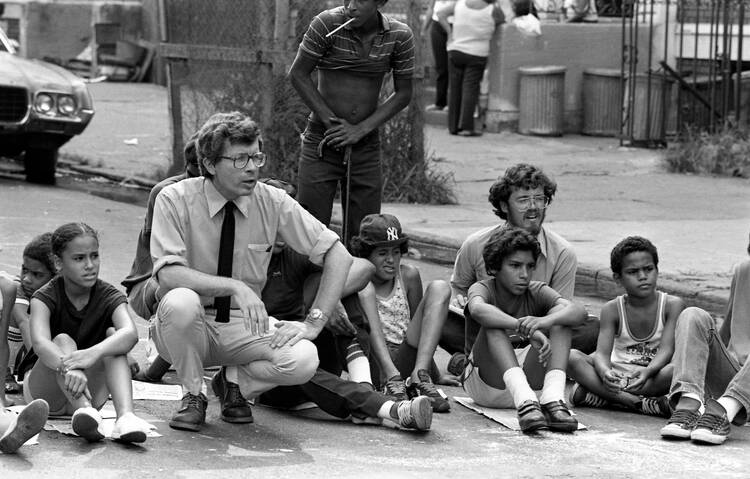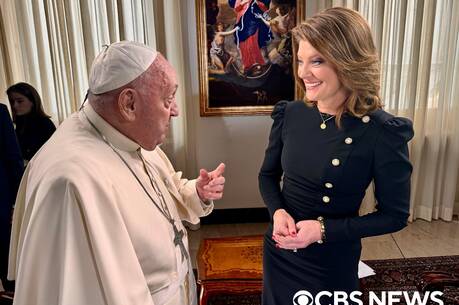Orlando introduces himself, then swallows hard and blinks back tears. “He saved my life.” In a funeral parlor in Queens, N.Y., a crowd of people, mostly in their 50s and 60s, has gathered to mourn Edward Eismann, who died in June at the age of 91. Dr. Eismann—everybody called him Doc—founded Unitas Therapeutic Community, a program in the South Bronx that understands social connectedness as key to mental health. Drawing on Adlerian psychology of social purpose, he believed a child grows healthy caring for others: that empathy is restorative. Dr. Eismann structured Unitas around surrogate families—groups of teens and younger children assigned to care for each other in cascading mentorship that also supported birth families. As they spoke at the funeral home, those who had grown up in Unitas testified to its profound influence in their life.
Dr. Eismann arrived in the Bronx in 1967 to work at a community mental health clinic run by Lincoln Hospital. Frustrated that few people came through its doors, he began walking through the streets instead. The young white man stood out in a Black and Puerto Rican neighborhood. Children and teens asked him what he was about. He said he was a doctor who helped young people with their worries. Day after day he left the clinic and sat on a stoop. Soon a group of young people were meeting with him regularly, relieved to play in the calming company of someone who wanted to hear their thoughts.
Meeting outdoors every day in the summer, as many as 100 children sat cross-legged in a circle on Fox Street, and later in front of St. Athanasius Church around the corner. In winter they met in the gym. They listened to stories and talked about their meanings. The older children got training in social work techniques. The circle became a place young people could bring their worries and fears, their joys and hopes. Together, they would work out their troubles.
Together, they would work out their troubles.
“He was saying something to Black and Latino young men and women that nobody was saying to us at that time. And that was that we can be effective helpers of each other, and we can be like an emergency network,” said James Arana, who came to Unitas in 1974 at age 14, while the organization was still operating under the auspices of Lincoln Hospital. (It became independent in 1977.) “This was a unique idea for young people like me, when everything around us was saying, ‘If you’re Black and Latino, we can only expect the worst of you.’”
The South Bronx in that era was falling apart. The Cross Bronx Expressway, built between 1948 and 1972, had sliced across the borough, spewing exhaust and grime. White flight caused the population to crater. As New York’s economy deindustrialized, blue-collar jobs that supported previous waves of migrants evaporated. Heroin flooded the neighborhood, frequently brought home in the veins of Vietnam veterans in a community with disproportionately high rates of military service; there were few deferments from the draft for the poor.
Muggings and gang battles made the streets treacherous. Urban renewal projects had left piles of rubble but few new buildings. In many apartments, landlords failed to provide heat; some, unable to finance repairs because banks would not lend in neighborhoods of color, walked away from the buildings entirely. With firehouses shuttered to balance the city’s budget, fires roared through the neighborhood. Racist public policy created angry, frightened children and struggling families.
The South Bronx’s ills were structural. If its children were to survive, they would need to build up alternative social structures. If society had reneged on its social contract with the South Bronx, Dr. Eismann taught children they could commit to each other. They possessed the ability to heal—themselves and others.
Unitas was part of a cluster of Catholic-related efforts that bloomed in the South Bronx in its hardest years, all of them built around a collective ethos. SEBCO, a nonprofit housing group founded by the Rev. Louis Gigante at St. Athanasius Church, and Mid-Bronx Desperados, associated with St. John Chrysostom parish, rebuilt the physical environment. South Bronx People for Change, an activist organization inspired by liberation theology, built political power. Unitas was for the soul, explained Severo Escalera, known as Papo, who joined as a sixth grader in 1971 and remains close to the organization.
Edward Eismann grew up in Brooklyn. A sensitive child with a perfectionist streak, he played piano with breathtaking beauty. He joined the Congregation of the Holy Cross to become a priest but left before final vows and earned a doctorate in clinical social work at Smith College. He never married, though he eventually adopted a son. Dr. Eismann spoke slowly, exuding a deep gentleness that was disarming, particularly on tough streets. “He could be on any block in the South Bronx and no one would mess with him,” said Mr. Escalera. “The gang members would get off the block when the circle was operating.” Dr. Eismann chose the name Unitas based on Psalm 133: How good and noble it is when brothers and sisters dwell together in unity.
“People heal by being together, people heal by telling stories,” said John Gill, a staff counselor at Unitas in the 2000s who is now a social worker in Oakland, Calif., using hip-hop in therapy. While the program never mentioned religion explicitly—it is a social service agency run on government funds—the work was deeply spiritual, said Marianne Kraft, who as principal of St. Athanasius School worked in close cooperation with Unitas for decades. “We didn’t use language about God, but it was about noticing that spark, that beauty,” she said. “At Easter he told a story, it was really the story of Emmaus,” she explained. Eismann broke bread into pieces, telling the children to hold it, waiting until everyone had bread. Then he told them to turn to each other and recognize how precious each was.
John Gill: "People heal by being together."
People who grew up in Unitas carry it with them. Mr. Arana, now a clinical social worker, leads trainings against sexual violence in Rwanda and Liberia, using Unitas methods. Mr. Escalera relies on skills he learned from Dr. Eismann to counsel neighbors. Wilson Martinez, a deacon, who worked as a counselor at Unitas in the ’70s, sees it in his ministry. Scores of others who once sat in the circle on Fox Street apply its lessons in their communities today.
Despite his transformative impact on so many lives, in his final years Dr. Eismann was tormented with what friends called scrupulosity, the psychological or spiritual condition of a hyper-active conscience. It hounded his daily decisions—what to eat, what to wear—and sent his mind rattling through the past. Had he done enough? Why hadn’t Unitas solved all the problems? Was God displeased with him? He stopped playing the piano, finding no joy in it. For a man whose obra—his life’s work—was community, the social isolation of Covid-19 was devastating. The deaths in recent years of a close cousin and his beloved dog destabilized him, friends said. Mr. Arana visited every other week from Massachusetts, Mr. Escalera even more often. Dr. Eismann’s son arranged care and tried to offer comfort. But it was as though Dr. Eismann had been severed, unable to extend to himself the healing he taught others. His body frail and weakened, he died at the end of June.
Those who came through Doc Eismann’s Unitas learned that in community there is strength. This did not change the economic conditions, but it showed that loving each other is powerful. In the simple funeral parlor where his wake was held, the grown children of the South Bronx, sweet burly men and women on whose faces were written a lifetime of care, sat in rows. Then they pushed their chairs to the edges of the room until, like little children again, they formed a circle. They faced each other. His work had been mighty, they said. They would praise Doc, commending him home. This was the communion they had learned to enact.
Correction: An earlier version of this article stated that the Unitas gatherings took place only on Fox St. In fact, they later moved to a location around the corner on Tiffany St.








